1. Overview
Health is a very important sector in development as it is related to three of the eight MDGs. These goals are the fourth goal; reducing childhood mortality, the fifth goal; enhancing maternal health, and the sixth goal; combating HIV/AIDS, malaria and other diseases. Health is also indirectly related to the other MDGs, such as the first goal; reducing pain and hunger, the seventh goal; enhancing access to safe water, and the eighth goal; providing necessary medicine in developing countries.
KOICA’s philosophy on ODA maintains that support to the Health sector is needed to build‘ social opportunities and safety nets.’KOICA supports the‘ Medical Insurance Project in Nepal’and medical insurance related activities through the ‘Sharing Development Experience with Vietnam’project. This project provides to support people who face sudden unemployment due to disease or people suffering from the economic burden caused by excessive medical expenses. One reason this sector is so important is that health is an indicator of basic human rights as well as an important contributing element to sustainable development.
2. Performance
KOICA provides many different forms of assistance in the health sector, including carrying out Health sector projects, dispatching volunteers and medical staff, inviting trainees to Korea, and field training. From 1991 to 2010, KOICA’s total spending in the Health sector accounted for 16.5% of its entire expenditure and this percentage has been increasing every year. In 2010, 16.9% was spent on the Health sector.
Health projects in the Asian region received the highest spending, 35% of KOICA’s budget for this sector, due to its traditional cooperative relationship, geographic accessibility, and cultural similarities with Korea. Since 2003, as Iraq and Afghanistan needed intensive support for postwar reconstruction, the Middle Eastern region is ranked as KOICA’s second largest recipient, receiving 20% of the total health spending. The Africa region (17%) and Latin America (15%) are the next largest recipients. Specifically, KOICA’s intensive support to Peru’s health sector makes up a substantial amount of Latin America’s assistance and needs to be noted. KOICA undertook 143 projects and 2 development research projects between 1991 and 2010 in addition to hosting 141 training sessions for invited trainees. KOICA has also deployed a total of 72 medical experts and 983 other volunteers work on health sector projects in developing countries.
A. Expanding Quality Health Service
Access to health services in developing countries is generally insufficient for all classes of society; however, the poorest people have particular difficulty as their access is even more limited due to their low social standing. This results from the absence of medical insurance systems, the lack of human resources in the health sector, and the shortage of quality health infrastructure. In order to improve this condition and expand basic medical service in developing countries, KOICA has endeavored to provide health services and provide medical instruments. Also, KOICA has tried to enhance the quality of health care by promoting human resource development in the health sector.
KOICA’s first health care project was the establishment of the Korea-Peru Medical Center in two phases, 1992-93 and 1993-94 respectively. This project aimed to promote quality health care services by providing medical equipment and constructing the physical facilities. Various other health projects have been carried out, ranging from establishing primary care facilities to tertiary hospitals depending on the need of the target area.
B. Enhancing Maternal and Child Health
In the year 2009 alone, more than 8 million children did not reach the age of five and 350,000 mothers died in labor. In light of this tragic issue, KOICA has been promoting projects to reduce child and maternal mortality death rates.
Some of the most successful cases of KOICA’s maternal and child health projects are the‘ Family Planning and Maternal and Child Health Promotion in the Arsi zone of Ethiopia’(2008~2010) and the first and second projects for‘ Maternal and Child Health Promotion’in Guatemala (2007~2009, 2010~2012).
[Figure 2-1] A Mother and a Child visit the Family Planning Center in the Arsi zone in Ethiopia

• Since 2009 KOICA has been operating Family Planning Center in the Arsi zone of Ethiopia. At this center, KOICA has provided family planning education to a total of 4,791 people and offered consultation on family planning to 17,268.
C. Combating and Preventing HIV/AIDS, Malaria, Tuberculosis and other Infectious Diseases
Every day, HIV/AIDS infects almost 7,500 people and kills 5,500. The immense scale of this epidemic is due to the lack of prevention and treatment for this infectious disease. With the goal of providing treatment and managing precautionary programs to reduce breakouts, KOICA has carried out projects to foster health experts and medicine distribution. By using the Global Anti-Poverty Contribution Fund created to improve Africa’s health condition, KOICA has been supporting the prevention and eradication of infectious diseases by supplying mosquito nets to people in the Democratic Republic of the Congo.
[Figure 2-2] Supplying Mosquito Nets to the Malaria Affected Areas in the Democratic Republic of the Congo
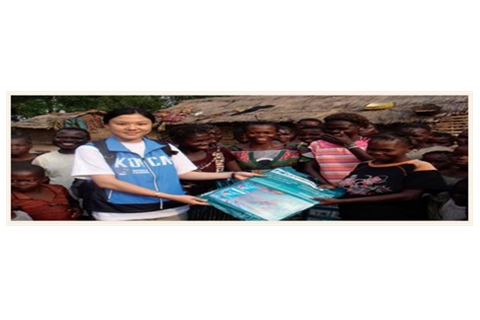
• Since 2009, Korea has been supplying insecticide-treated mosquito nests to people living in tropical rain forest in the Democratic Republic of Congo funded by the Global Anti-poverty Contribution Fund, Cho Hye-seung, the head of KOICA office, poses with the people of Congo
D. Supplying Safe Water and Sanitation
Since 1990, 1.6 billion people have gained access to safe drinking water. Despite this progress, almost 1 billion of people are still suffering from a shortage of drinking water. Additionally, one fourth of the population in developing countries lives without sanitary facilities. Although 15% of the world’s population does use sanitary facilities, many do not have proper sanitary disposal facilities. Negligence in the disposal of human excrement can threaten the health of the people handling the waste as well as the entire community. KOICA has contributed to enhancing living standards and satisfying basic human needs by supplying safe drinking water facilities, thereby reducing waterborne diseases.
[Figure 2-3] People Using Clean Water after the Drinking Water Supply Project in Kenya

• Various types and scales of projects are implemented from smaller scale projects such as digging a well or remodeling an existing well to bigger scale projects enabling households to use safe water by delivering drinking water supply services.
Source: Korea International Cooperation Agency. 2011. 20 years of KOICA 1991-2010, Translated by Institute for Development and Human Security, Ewha Womans University. Seoul.
(3) Strategy and Institutional Improvement
After establishing its ODA implementation framework through a sector based approach, KOICA set up the following three strategies in the Health sector: Institutional Capacity Building, Human Resource Development, and Creating Health Related Resources. Furthermore, four subordinate goals were selected to consider while carrying out the grant aid projects: Expansion of better health services, Enhancing maternal and child health, Combating HIV/AIDS, malaria, and infectious diseases, and Supplying safe drinking water and sanitation facilities.
Establishing a basic level of health in developing countries is the foundation necessary for breaking the vicious cycle of poverty. Without a healthy population, these countries will never have the human resources they need to further their development. In 1948 The Universal Declaration of Human Rights named health as a basic human right, and KOICA recognized the importance of this right as is reflected in its vision of“ a prosperous and stable international community achieved with the help of KOICA’s contributions to the health sector in developing countries.”To realize this vision, KOICA set out two directives of strengthening health and medical care systems and strengthening support for people vulnerable to disease.
Each directive aims to solve health problems in developing countries and assist the global community in achieving the MDGs. Five strategic goals were selected to strengthen health and medical systems; strengthening the capacity of human resources in the health sector, strengthening the institutional capacity of the health system, expanding access to health and medical service, enhancing maternal and child health and family planning and strengthening the prevention and management of infectious diseases. These strategic goals make KOICA’s projects more effective in supporting the vulnerable classes, combat major diseases, and furthering progress towards achieving the MDGs. The MDGs being targeted by these goals are goal 4, reducing child mortality rate goal; goal 5, improving maternal health; and goal 6, combating HIV/AIDS, malaria and other diseases.
In 2004, KOICA recognized the building of health and medical centers as its primary health service project and published the ‘Health Project Basic Model Plans.’This guideline offers models for project implementation from the onset of project selection and pre-survey stages. This guideline also promotes project efficiency by providing a project implementation checklist, a standard equipment list with pictures, detailed specifications for treatment, price trends, and an application survey. In line with the sector-based project system established in 2005, the ‘sector-based promotion direction of development aid’had a definition, vision, promotion direction, and strategy goals for the health sector and was prepared to promote aid projects. These strategies and the project implementation model function as guidelines selecting partner countries for ODA projects.
In 2007, KOICA established the ‘Mid-term Strategy for International Grant Aid (2008~2010)’laying out the basic goals, direction, and a three year project promotion plan for projects in the Health sector. Moving further from projects that simply supply development facilities, project promotion plans were established to align with the MDGs and to take the health and medical situation of partner countries and regions into consideration. Also, by setting up the mid-term strategy, KOICA clarified its project strategies, goals, and detailed support model. While KOICA was setting up this plan, it was also simultaneously carrying out facility support projects, institutional capacity building projects, and human resource development projects. This now serves as the foundation for program-based approach projects.
[Figure 2-4] The Health Sector Strategy
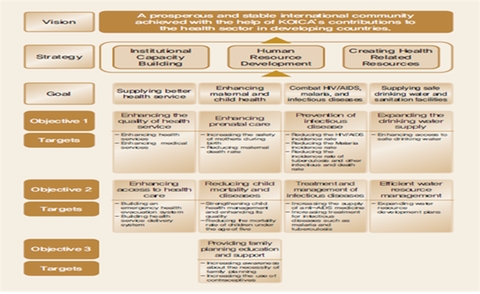
KOICA has worked hard to build cooperation networks with individuals and institutions that have accumulated expertise and knowhow during Korea’s development process. These external experts and specialized institutions have participated in KOICA’s programs through information sessions on health projects and the appointment of consultants for more effective project implementation in the health sector since 2009.
Since 2010, KOICA solidified its leading position in ODA by hosting a forum on the ODA health sector for enhancing the quality of projects. The mid-term strategy goals (2010~2015) were newly established to prepare the basis for long-term aid implementation. Also, KOICA has made efforts to ensure the internal stability of health projects through various forms of comprehensive assistance programs.
Source: Korea International Cooperation Agency. 2011. 20 years of KOICA 1991-2010, Translated by Institute for Development and Human Security, Ewha Womans University. Seoul.
(4) Best Practices
A. Family Planning and Maternal and Child Health Project in the Arsi, Ethiopia
Ethiopia is one of the least developed countries in the world with a per capita income of USD 330. Ethiopia’s economic growth has shown very little progress due to the rapidly increasing population. Despite family planning programs implemented by the Ethiopian government and international NGOs over the years, the population growth rate reached a high 2.8% from 2000 to 2005. This rapid expansion of the population exacerbates the food shortage and becomes a severe obstacle to economic growth in a country where half of the population is living in extreme poverty.
[Figure 2-5] KOICA’s Family Planning Campaign in Ethiopia
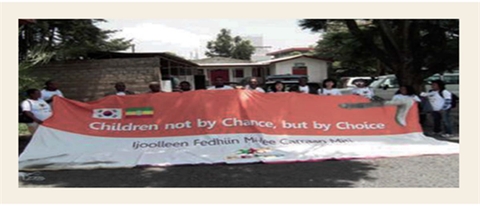
According to a survey conducted prior to project implementation, 50% of Ethiopian women want contraception, but the actual rate of contraceptive use is only 15% because of low access to family planning service and a shortage of birth control goods.
In order to improve this situation, the government of Ethiopia requested support from Korea to enhance family planning and maternal and child health in the Arsi zone, the area near the capital city of Adis Ababa. Thanks to this assistance, a maternal and child health center and three family education centers were established in Hetosa woreda area in the Arsi zone. Also, a Korean family planning expert was sent to the field to conduct contraception education and to oversee the project.
[Figure 2-6] A Dispatched Korean Nurse Takes Care of an Ethiopian child
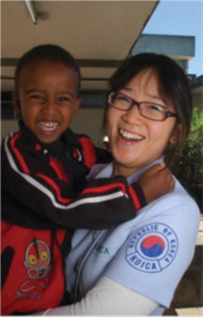
As a result of this project, the family planning knowledge in the area has successfully spread. KOICA has offered these health services through a community-based participatory approach, and has provided family planning services for the local people by providing information on family planning through education and consultation. The local people’s access to this type of information is expected to increase greatly in the future, thanks to the maternal and child health center established by KOICA. Other ways in which KOICA has enhanced family planning in this area are by strengthening the capacity of nurses and health extension workers and by encouraging the community’s active participation in the project through the organization of a resident’s committee. This project has been evaluated as one of Korea’s best maternal and child health ODA projects and has been adopted into the Ethiopian government’s policy.
In the short term, it is expected to improve Ethiopia’s family planning and maternal and child health. However, the ultimate long term goal of this project is to contribute to poverty alleviation and sustainable economic and social development.
B. Drinking Water Development in Kien Giang Province U Minh and Vinh Binh Nam Regions in Vietnam
Since 2000, the government of Vietnam has been promoting the ‘National Rural Clean Water Supply and Sanitation Strategy up to Year 2020’ to enhance public health and seek balanced development between urban and rural areas. With this campaign, Vietnam aims to supply clean water to 85% of the population by 2010 and to all of the people by 2020. The Kien Giang province, located in the southernmost west costal area in Vietnam, is home to around 1.68 million members of minority groups.
It has poor living conditions compared to other regions due to its climate and geographic location. One particular challenge is a lack of safe drinking water; there are difficulties in using the underground water due to the high concentration of salt. In some areas underground water is not even available. In order to raise the living standards of the local people and to promote community development, the government of Vietnam established a new town development plan in the U Minh area and requested that Korea assist in laying out the infrastructure.
In response to this request, KOICA has supported a project for drinking water development in the U Minh new town and Vinh Binh Nam region spending a total of USD 2.4 million since 2007. The underground water has been processed to meet the standard of drinkable water quality. Then KOICA helped build up a water supply system for each project region in order to create a stable clean water supply to each household through a water pipeline. By establishing the drinking water supply system, about 2,400 tons of clean water was supplied to the U Minh and 300 tons to the Vinh Binh Nam region daily.
These people no longer needed bring in drinking water from outside the region and were released from the danger of waterborne disease symptoms such as diarrhea and vomiting.
C. The Health Project in Peru
Since the founding of KOICA in 1991, there have been a total of three program-based projects including the first Korea-Peru Health Center Construction Project. Since then health projects in Peru have continued to grow. The fifth project established a Korea-Peru Hospital in 2009 and the sixth project constructed a Korea-Peru Health Care Center in Pachacutec in 2007. The ‘Korea-Peru Health Care Center’project has seen such remarkable results that the President of Peru announced that the Pachacutec Health Care Center will be used as a standard model for Peru’s future health care centers. The Peruvian government has built 6 additional hospitals based on this model.
[Table 2-7] KOICA’s 6 Health Projects in Peru
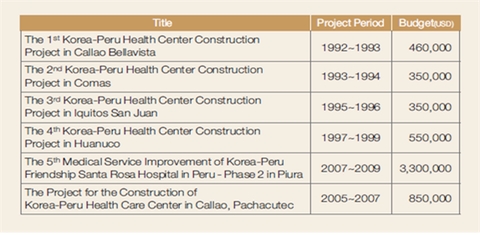
Established in Callo, the first health center’s two year construction and establishment started in 1992 with a total budget of USD 460,000. The second health center was constructed in the slum area of Comas in the capital city of Lima. The third health center was constructed west of the Andes Mountains in Iquitos, the central city of Amazon, with a budget of USD 350,000. The forth health center was established in Huanoco from 1997 to 1999 spending USD 550,000. This forth Korea-Peru health center is equipped with a department of radiology, a clinical laboratory, an infant unit, an emergency patient treatment center, a department of internal medicine, a department of surgery, a department of obstetrics and gynecology, and a pediatric department. It treats 60,000 people annually. The fifth Korea-Peru hospital was constructed in 2004 in the Piura province, a border area between Peru and Ecuador.
These construction projects are particularly meaningful because they have been combined with human resource development by dispatching overseas volunteers and medical staff. In a post-project evaluation conducted in 2010, the six hospitals in Peru have advanced their management since their foundation and are providing better quality primary health care in each targeted area.
[Figure 2-8] A KOICA International Cooperation Doctor treating a patient in a poor village in Peru
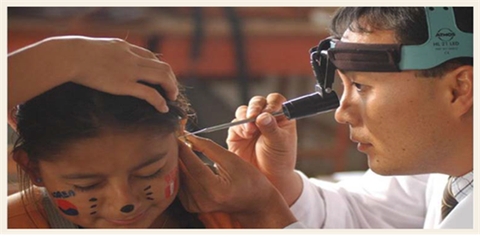
• Dr. Oh Chung-hyun, M.D. (otolaryngology) has completed his three-year term as a KOICA cooperation doctor since 2008 and is currently working as a specialized researcher at KOICA.
Source: Korea International Cooperation Agency. 2011. 20 years of KOICA 1991-2010, Translated by Institute for Development and Human Security, Ewha Womans University. Seoul.
